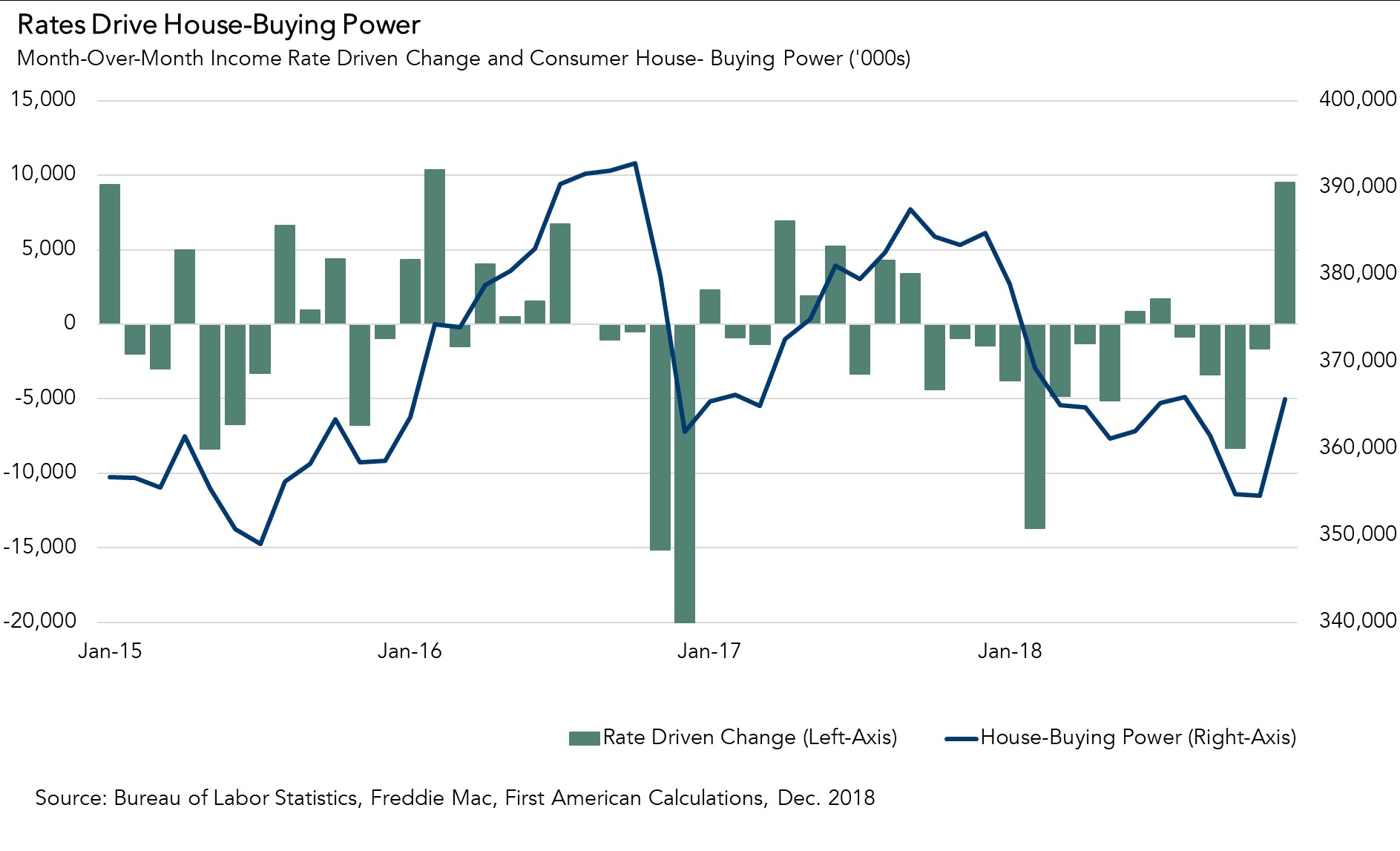Housing affordability is a function of three economic drivers: nominal house prices, household income and mortgage rates. When incomes rise, consumer house-buying power increases. Declining mortgage rates or declining nominal house prices also increase consumer house-buying power. Our Real House Price Index (RHPI) uses consumer house-buying power to adjust nominal house prices, offering insight into shifts in affordability.
“December delivered a significant holiday housing affordability boost to prospective home buyers.”
While housing affordability in 2018 fared poorly in comparison to 2017, decreasing 11.8 percent in December compared with a year earlier, the year finished strong in December thanks to declining mortgage rates. Mortgage rates in December fell 0.23 percentage points compared with the previous month and household income increased 0.4 percent. The effect? A 3.1 percent increase in house-buying power, the largest monthly gain in more than five years. As a result, real house prices experienced the largest monthly decline (2.4 percent) since 2016. December delivered a significant holiday housing affordability boost to prospective home buyers.
December’s Double Whammy: Rising Wage Growth and Lower Mortgage Rates
In December, the labor market remained impressive. Annual hourly wage growth increased by 3.5 percent compared with a year earlier, and the labor market’s record streak of job gains continued. The labor market has increased average household income by 55 percent since January 2000. In 2018, the increase in household income helped mitigate the impact of rising mortgage rates and the fast pace of unadjusted house price growth on affordability. Rising mortgage rates, which increased from 4.0 to 4.6 percent in 2018, reduced consumer house-buying power by nearly $31,000. The growth in household income, however, increased consumer house-buying power by $11,000. The overall net effect in 2018 of the affordability tug-of-war between increasing mortgage rates and income growth was a $19,000 decline in house-buying power, compared with December 2017.
However, the affordability trend shifted toward buyers in December, as mortgage rates fell and household income continued to grow. The December decline in mortgage rates from 4.87 to 4.64 percent boosted house-buying power by an impressive $10,000. That means a home buyer with a 5 percent down payment and a mortgage rate of 4.6 percent saw their house-buying power increase from $354,500 to $364,500. The monthly increase in household income further increased house-buying power to $365,600. Overall, house-buying power increased by $11,100 in December compared with the previous month, the second largest monthly increase in house-buying power since the beginning of the millennium.

The RHPI is updated monthly with new data. Look for the next edition of the RHPI the week of March 25, 2019.
Sources:
December 2018 Real House Price Index Highlights
The First American Real House Price Index (RHPI) showed that in December 2018:
- Real house prices decreased 2.4 percent between November 2018 and December 2018.
- Real house prices increased 11.8 percent year over year.
- Consumer house-buying power, how much one can buy based on changes in income and interest rates, increased 3.1 percent between November 2018 and December 2018, and declined 5.0 percent year over year.
- Average household income has increased 3.1 percent since December 2017 and 55.0 percent since January 2000.
- Real house prices are 12.0 percent less expensive than in January 2000.
- While unadjusted house prices are now 2.0 percent above the housing boom peak in 2006, real, house-buying power-adjusted house prices remain 37.2 percent below their 2006 housing boom peak.
December 2018 Real House Price State Highlights
- The five states with the greatest year-over-year increase in the RHPI are: District of Columbia (+19.1 percent), Ohio (+17.0 percent), Montana (+16.7 percent), Nevada (+16.6 percent), and New Jersey (+16.4 percent).
- No state had a year-over-year decrease in the RHPI in December.
December 2018 Real House Price Local Market Highlights
- Among the Core Based Statistical Areas (CBSAs) tracked by First American, the five markets with the greatest year-over-year increase in the RHPI are: Cleveland (+20.1 percent), Las Vegas (+19.9 percent), Orlando, Fla. (+19.8 percent), Charlotte, N.C. (+19.5 percent), and Columbus, Ohio (+18.2 percent).
- No CBSA had a year-over-year decrease in the RHPI in December.
Deputy Chief Economist Odeta Kushi contributed to this blog post.



